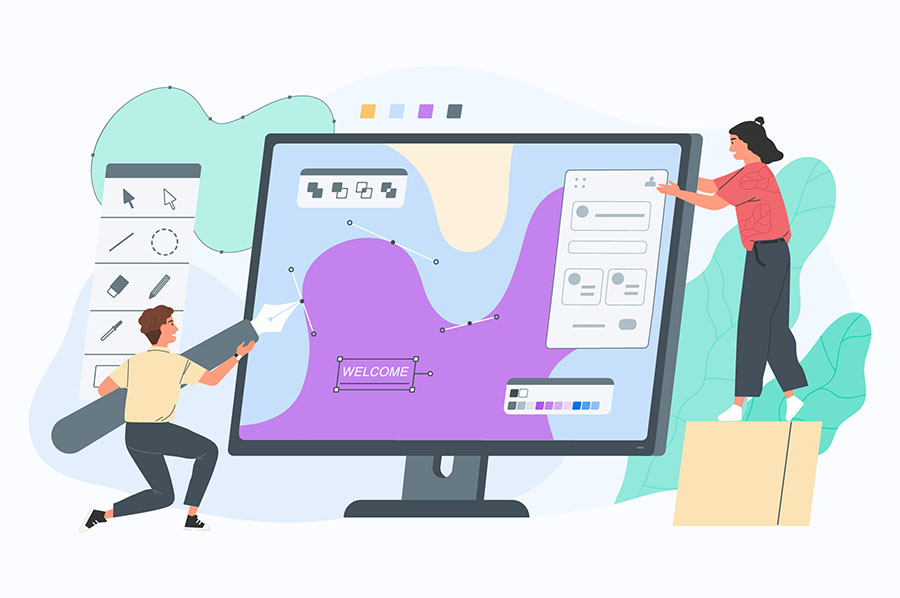All Categories
Featured
Table of Contents
- – Webpage Design (Article) - Further Learning - ...
- – Web Design Tutorials By Envato Tuts+ Tips and...
- – Web Design Ledger: Homepage Tips and Tricks:
- – Ciw Web Design Series Tips and Tricks:
- – Minneapolis Web Design - 100+ Five Star Revie...
- – The Top Ecommerce, Website Design ... - Seatt...
- – Web Design Museum 1991 – 2006 Tips and Tricks:
- – Why Good Web Design Is Important, And Why Yo...
- – Web Design Software By Xara Tips and Tricks:
- – Web Design Vs. Web Development - Upwork Tips...
- – The Top 10 Most Important Elements Of A Webs...
Webpage Design (Article) - Further Learning - Khan Academy Tips and Tricks:
Quick summary Usability and the utility, not the visual style, determine the success or failure of a website. Given that the visitor of the page is the only individual who clicks the mouse and therefore chooses whatever, user-centric style has established as a standard method for successful and profit-oriented website design - web design frederick md.
and the utility, not the visual style, identify the success or failure of a site. Given that the visitor of the page is the only individual who clicks the mouse and therefore decides whatever, user-centric design has ended up being a basic approach for successful and profit-oriented website design. After all, if users can't utilize a feature, it may as well not exist.
g. where the search box must be placed) as it has currently been done in a number of posts; instead we focus on the techniques which, utilized correctly, can result in more advanced design choices and simplify the procedure of viewing presented info. Please observe that you might be thinking about the usability-related posts we've published prior to: Concepts Of Great Website Style And Efficient Website Design Guidelines, In order to utilize the principles properly we first require to comprehend how users engage with websites, how they think and what are the standard patterns of users' habits.
Web Design Tutorials By Envato Tuts+ Tips and Tricks:
Visitors look at each new page, scan some of the text, and click the very first link that catches their interest or vaguely looks like the thing they're trying to find. In fact, there are large parts of the page they do not even look at. Many users browse for something interesting (or beneficial) and clickable; as quickly as some promising candidates are found, users click.
If a page offers users with top quality material, they are ready to compromise the material with advertisements and the design of the website. This is the reason why not-that-well-designed websites with high-quality content gain a great deal of traffic over years. Content is more crucial than the style which supports it.

Very simple principle: If a website isn't able to satisfy users' expectations, then designer failed to get his task done effectively and the company loses money. The greater is the cognitive load and the less intuitive is the navigation, the more prepared are users to leave the website and search for alternatives.
Web Design Ledger: Homepage Tips and Tricks:
Neither do they scan website in a linear fashion, going sequentially from one site area to another one. Rather users satisfice; they pick the first reasonable option. As quickly as they find a link that looks like it may lead to the objective, there is a very good opportunity that it will be immediately clicked.
It does not matter to us if we comprehend how things work, as long as we can use them. If your audience is going to act like you're designing billboard, then design terrific billboards." Users desire to have the ability to manage their browser and count on the constant data discussion throughout the site.
If the navigation and website architecture aren't intuitive, the number of concern marks grows and makes it harder for users to understand how the system works and how to obtain from point A to point B. A clear structure, moderate visual ideas and quickly recognizable links can assist users to discover their course to their goal.
Ciw Web Design Series Tips and Tricks:

claims to be "beyond channels, beyond products, beyond distribution". What does it suggest? Because users tend to explore websites according to the "F"-pattern, these three statements would be the first components users will see on the page once it is packed. The design itself is easy and intuitive, to understand what the page is about the user requires to search for the response.
Once you've accomplished this, you can communicate why the system is useful and how users can benefit from it. People won't use your website if they can't find their method around it. 2. Don't Misuse Users' Patience, In every task when you are going to use your visitors some service or tool, try to keep your user requirements very little.
Novice visitors are willing to, not filling long web kinds for an account they may never utilize in the future. Let users check out the website and find your services without requiring them into sharing personal information. It's not sensible to require users to enter an e-mail address to check the function.
Minneapolis Web Design - 100+ Five Star Reviews - Seo ... Tips and Tricks:
Stikkit is a perfect example for an user-friendly service which requires almost absolutely nothing from the visitor which is unobtrusive and reassuring. And that's what you desire your users to feel on your web website. Apparently, Termite requires more. Nevertheless the registration can be done in less than 30 seconds as the kind has horizontal orientation, the user doesn't even need to scroll the page.
A user registration alone is sufficient of an obstacle to user navigation to cut down on incoming traffic. Manage To Focus Users' Attention, As sites offer both static and vibrant material, some aspects of the user interface attract attention more than others do.
Focusing users' attention to particular areas of the site with a moderate use of visual aspects can help your visitors to get from point A to point B without thinking of how it actually is supposed to be done. The less enigma visitors have, the they have and the more trust they can develop towards the company the website represents.
The Top Ecommerce, Website Design ... - Seattle Tips and Tricks:
Strive For Feature Direct exposure, Modern web designs are usually criticized due to their approach of guiding users with aesthetically appealing 1-2-3-done-steps, large buttons with visual results and so on. From the design point of view these elements in fact aren't a bad thing.
The site has 9 primary navigation alternatives which are visible at the very first glance. What matters is that the content is well-understood and visitors feel comfortable with the method they communicate with the system.
com gets directly to the point. No cute words, no overemphasized declarations. Rather a cost: simply what visitors are searching for. An optimum option for effective writing is touse brief and succinct phrases (come to the point as quickly as possible), usage scannable layout (categorize the material, utilize several heading levels, utilize visual components and bulleted lists which break the circulation of uniform text blocks), use plain and objective language (a promo does not need to sound like ad; offer your users some reasonable and unbiased reason they should utilize your service or remain on your site)6.
Web Design Museum 1991 – 2006 Tips and Tricks:
Users are seldom on a site to take pleasure in the style; moreover, in many cases they are trying to find the details in spite of the style - web design frederick md. Pursue simpleness rather of complexity. From the visitors' point of view, the very best site style is a pure text, without any advertisements or additional content obstructs matching precisely the inquiry visitors utilized or the content they have actually been looking for.
Finch plainly presents the info about the website and gives visitors a choice of choices without overcrowding them with unneeded material. 7. Do not Be Afraid Of The White Area, Actually it's truly difficult to overestimate the significance of white space. Not just does it assist to for the visitors, however it makes it possible to perceive the information presented on the screen.
Complex structures are harder to check out, scan, evaluate and deal with. If you have the option between separating two design sectors by a visible line or by some whitespace, it's typically much better to use the whitespace solution. (Simon's Law): the better you manage to offer users with a sense of visual hierarchy, the much easier your material will be to view.
Why Good Web Design Is Important, And Why You Need It Tips and Tricks:
The very same conventions and rules ought to be applied to all elements.: do the most with the least quantity of cues and visual aspects. Clearness: all elements need to be developed so their significance is not uncertain.
Conventions Are Our Friends, Standard style of site components doesn't result in an uninteresting website. As they minimize the finding out curve, the need to figure out how things work. It would be an use nightmare if all sites had various visual presentation of RSS-feeds. That's not that various from our routine life where we tend to get utilized to fundamental principles of how we organize information (folders) or do shopping (placement of products).
understand what they're expecting from a website navigation, text structure, search placement etc. A case in point from usability sessions is to translate the page in Japanese (presuming your web users don't understand Japanese, e. g. with Babelfish) and provide your functionality testers with a task to discover something in the page of different language.
Web Design Software By Xara Tips and Tricks:
Steve Krug suggests that it's better to, however benefit from conventions when you don't. 10. Test Early, Test Often, This so-called TETO-principle ought to be used to every website design project as functionality tests frequently provide into substantial issues and problems associated with a given design. Test not far too late, not too little and not for the incorrect reasons.
Some important indicate keep in mind: according to Steve Krug, and screening one user early in the task is much better than screening 50 near the end. Accoring to Boehm's very first law, mistakes are most regular during requirements and design activities and are the more pricey the later on they are gotten rid of.
That indicates that you develop something, test it, fix it and then check it again. There may be issues which have not been found during the preliminary as users were practically obstructed by other problems. use tests. Either you'll be indicated the problems you have or you'll be pointed to the lack of significant style defects which is in both cases a beneficial insight for your job.
Web Design Vs. Web Development - Upwork Tips and Tricks:

This holds for designers. After you have actually worked on a site for couple of weeks, you can't observe it from a fresh viewpoint any longer. You know how it is developed and therefore you understand precisely how it works you have the knowledge independent testers and visitors of your website would not have.
It can be connected to other areas such as graphic design, user experience, and multimedia arts, but is more aptly seen from a technological viewpoint. It has actually ended up being a big part of people's daily lives. It is hard to imagine the Internet without animated graphics, various styles of typography, background, videos and music.

During 1991 to 1993 the World Wide Web was born. Text-only pages might be seen using a simple line-mode internet browser. There had been no integrated method to graphic design elements such as images or sounds.
The Top 10 Most Important Elements Of A Website Design Tips and Tricks:
The W3C was developed in October 1994 to "lead the World Wide Web to its full potential by developing typical procedures that promote its advancement and ensure its interoperability." This discouraged any one company from monopolizing a propriety browser and shows language, which might have changed the impact of the Internet as a whole.
As this has actually occurred the technology of the web has also moved on. There have also been significant changes in the way people utilize and access the web, and this has altered how sites are designed. Because the end of the web browsers wars [] brand-new browsers have actually been released. Many of these are open source indicating that they tend to have quicker advancement and are more supportive of new standards.
Learn more about Lovell Media Group LLC or TrainACETable of Contents
- – Webpage Design (Article) - Further Learning - ...
- – Web Design Tutorials By Envato Tuts+ Tips and...
- – Web Design Ledger: Homepage Tips and Tricks:
- – Ciw Web Design Series Tips and Tricks:
- – Minneapolis Web Design - 100+ Five Star Revie...
- – The Top Ecommerce, Website Design ... - Seatt...
- – Web Design Museum 1991 – 2006 Tips and Tricks:
- – Why Good Web Design Is Important, And Why Yo...
- – Web Design Software By Xara Tips and Tricks:
- – Web Design Vs. Web Development - Upwork Tips...
- – The Top 10 Most Important Elements Of A Webs...
Latest Posts
10 Good Deeds In Web Design - Nielsen Norman Group Tips and Tricks:
Learning Web Design: A Beginner's Guide To Html, Css ... Tips and Tricks:
Web Design Ledger: Homepage Tips and Tricks:
More
Latest Posts
10 Good Deeds In Web Design - Nielsen Norman Group Tips and Tricks:
Learning Web Design: A Beginner's Guide To Html, Css ... Tips and Tricks:
Web Design Ledger: Homepage Tips and Tricks: